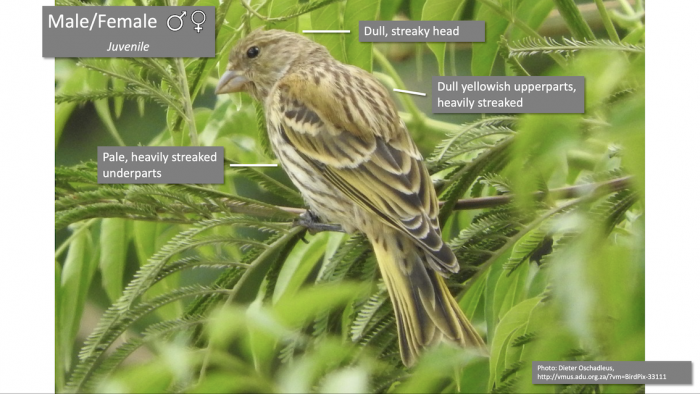Identification
The Cape Canary is a small, brightly-coloured birds. Males and females can be difficult to tell apart; you must look closely! Both sexes have yellow faces, but in males, the yellow runs all the way to the top of the head, forming a cap. In females, the top of the head is grey. There are a few other subtle differences to note: females have more dark streaks on their backs than males, and tend to be a paler yellow underneath.

Inset photo: Male Cape Canary. Kyle Finn, Knysna, Western Cape. 15 July 2014. BirdPix 88030
Juvenile Cape Canaries look quite different to adults; they are a dull, pale yellowish colour, and have heavy streaks all over their heads and bodies.


Immature: 6 December 2011. BirdPix 134701; Subadult: 13 June 2014. BirdPix 134703;
Adult: 22 June 2013. BirdPix 134702
You may have heard the expression “sing like a canary,” and for this species, the words are fitting! Cape Canaries belong to a group of birds called songbirds. Songbirds have specially developed vocal organs which allow them to produce complex songs, and Cape Canaries are no exception. Their ceaseless, cascading song is an iconic part of urban garden soundscapes. You can listen to their song here.
Habitat
Cape Canaries feed primarily on seeds, but will also eat fruits, flowers, and insects. They utilize a variety of habitats ranging from grassland, forest edges, and coastal sand dunes to residential gardens, agricultural fields and urban parks. Thanks to their seed-eating diet, Cape Canaries are often found at bird feeders.

Distribution
Because of their reliance on seeds and flowering plants, these birds are largely absent from the dry interior of southern Africa. This SABAP2 distribution map shows the wide belt of land they inhabit.

Cape Canaries are endemic; they are only found in southern Africa, and nowhere else in the world! Though their distribution reaches up into parts of Zimbabwe and Mozambique, Cape Canaries do not occur further north.
Behaviour
Cape Canaries are seldom seen (or heard) alone—they are gregarious. When breeding, these birds may be seen in small family groups or male-female pairs; outside of the breeding season, they often congregate in large flocks, sometimes with other seed-eating bird species. They are often seen foraging, searching for seeds in small groups or flocks.

Cape Canaries are sometimes easier to hear than to see—though they may choose conspicuous perches when singing, males will just as often sing from the tops of tall trees.
Cape Canaries usually nest alone, but if there is a lack of suitable places to build nests, several pairs of birds may nest in the same clump of trees. Females do most of the construction work, selecting a branch in a bush or tree and using a mixture of small twigs, leaves, roots, mosses, and even string to make a sturdy cup-shaped nest. The inside is lined with soft seeds, feathers, and hair.
Further resources
Species text in the first bird atlas (1997)
Virtual Museum (BirdPix > Search VM > By Scientific or Common Name)
More common names: Kaapse Kanarie (Afrikaans); Serin du Cap (French); Gelbscheitelgirlitz (German); Canario del Cap (Italian); Serín dorsigrís (Spanish)
Recommended citation format: Daniel KA 2021. Cape Canary Serinus canicollis. Biodiversity and Development Institute. Available online at https://thebdi.org/2021/10/27/cape-canary-serinus-canicollis/

